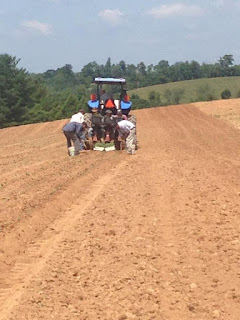Steve and I recently watched a presentation on the avian flu, which has been spreading across the western US killing millions of birds since December 2014. Egg prices are drastically increasing. Though no cases have been detected here thus far, many fairs and other events have been canceling or considering canceling their poultry shows.
Because of all this, I wrote an article on avian influenza to be published in the Carroll Extension Newsletter.
Avian Influenza,
or the bird flu, is a virus that infects wild birds and domestic poultry. There are two strains of the virus, low
pathogenic and highly pathogenic. Low path avian influenza, or LPAI, poses
little threat to human health. High path avian influenza, or HPAI, has a high
death rate in chicken and turkeys and spreads rapidly. According to the Centers
for Disease Control and Prevention, the risk to people from HPAI H5 is low.
Since December
2014, USDA has confirmed cases of HPAI H5 in the Pacific, Central, and
Mississippi flyways. The first detection was reported on December 19, 2014.
Since then there have been 223 detections reported. As of June 17, 2015 the
depopulation of 48,091,293 birds has been reported. The outbreaks began in
backyard flocks and the virus is believed to have been transmitted by wild
birds. It appears the virus was spreading in other ways as well due to the
number of farms affected and their proximity to one another. So far affected
states include: Washington, Oregon, California, Idaho, Montana, North Dakota, Nebraska,
Kansas, Minnesota, Iowa, Missouri, Arkansas, Wisconsin, and Indiana. The two
strains that are being detected are H5N2 and H5N8. There is no treatment for
the disease except for destruction of infected flocks.
Affected birds
include layer chickens, mixed game fowl, turkeys, pullet chickens, mixed
poultry, ducks, breeder chickens, and pheasants. It is being recommended that
backyard, hobbyist, and small local poultry producers take extra precautions to
prevent the flu from spreading to Virginia. So far, there have been no avian
flu detected in the Atlantic Flyway, but the risk will continue this fall as
birds begin to migrate south.
Warning signs of
avian flu include:
- Sudden high mortality rate
of 50-70 percent
- Reduced feed intake
- Reduced egg production
and misshapen eggs
- Swelling of the face and
hocks
- Sneezing, coughing, and
nasal discharge
The Animal andPlant Health Inspection Service has observed: sharing equipment between an
infected and noninfected farm, employees moving between infected and
noninfected farms, lack of cleaning and disinfection of vehicles moving between
farms, and reports of rodents or small wild birds inside poultry houses. These
are all examples of actions that could lead to the spread of avian influenza.
Agricultural
authorities are advising that small-scale producers practice basic biosecurity
to prevent the spread of avian flu to Virginia. Basic biosecurity practices
should include:
- Protect flocks from wild birds by
putting them in a coop if possible.
- Cover any exposed feed and water sources
that your flock uses. Don’t let domestic birds have access to streams or ponds.
- Limit exposure to other birds. Seal
structures where birds nest and cover holes. If birds have outside access,
cover the area to reduce exposure.
- Do not use wild bird feeders or
birdbaths that would attract other birds to areas that house poultry.
- If you hunt migratory birds you risk
exposing your flock to the virus. Have footwear and equipment that is dedicated
to be used on only your poultry flock.
For further information, contact the
Virginia Department of Agriculture and Consumer Services or
Virginia Cooperative Extension- Carroll County.





